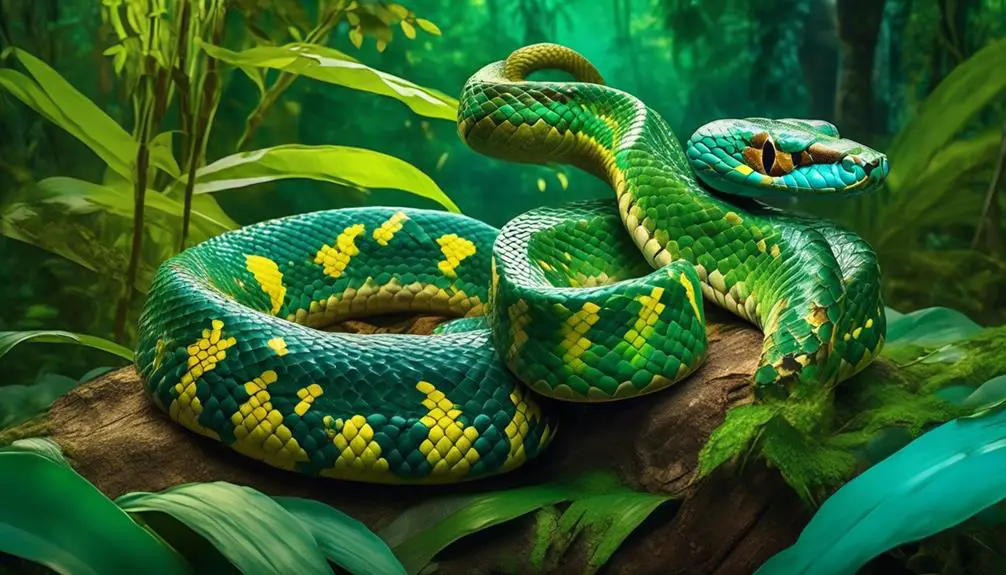Dare to venture into the perilous realm of Vietnam’s most venomous snakes, where danger lurks beneath the jungle foliage?
Prepare yourself for a captivating journey through the treacherous world of these lethal serpents.
From the stealthy White-lipped Viper, with its blistering bites, to the majestic King Cobra, capable of growing up to a staggering five meters, the enigmatic realm of these reptiles will both astonish and unsettle you.
But these are just the beginning of Vietnam’s venomous inhabitants.
Brace yourself as we unveil the secrets of the Feas Viper, the Red-headed Krait, the Malayan Krait, and more.
Are you ready to face the shadows and discover the most venomous snakes that call Vietnam home?
White-Lipped Viper (Trimeresurus albolabris)
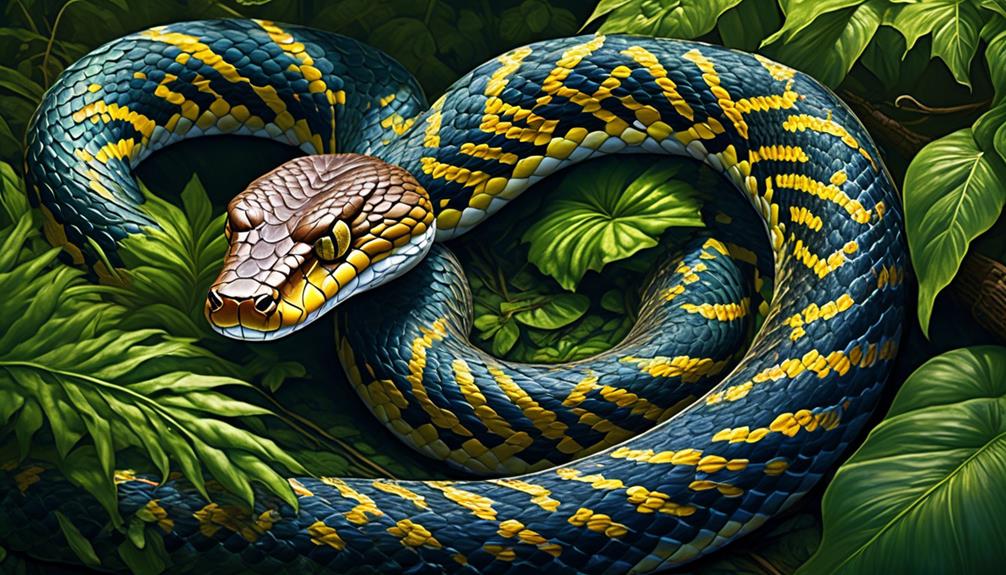
The White-Lipped Viper, scientifically known as Trimeresurus albolabris, is a venomous snake endemic to Southeast Asia, including Vietnam. This small snake typically measures less than a meter in length and is adept at camouflaging itself in the forests and bushlands of its habitat. While its bites can cause extreme pain, blistering, and swelling, the White-Lipped Viper isn’t known to be overly aggressive and rarely attacks without provocation.
The venom of the White-Lipped Viper contains a mixture of proteins and enzymes that can have various effects on its prey or potential threats. The venom primarily acts as a hemotoxin, causing damage to the blood vessels and surrounding tissues. This can result in local tissue necrosis, leading to severe pain and swelling. In some cases, the venom may also have cytotoxic effects, causing cell damage and further exacerbating the symptoms.
It is important to note that the severity of the symptoms can vary depending on various factors, such as the location and depth of the bite, as well as the individual’s sensitivity to the venom. Immediate medical attention is crucial in cases of White-Lipped Viper bites to prevent complications and ensure proper treatment. Antivenom specific to this species may be administered to help counteract the effects of the venom and aid in recovery.
King Cobra (Ophiophagus hannah)
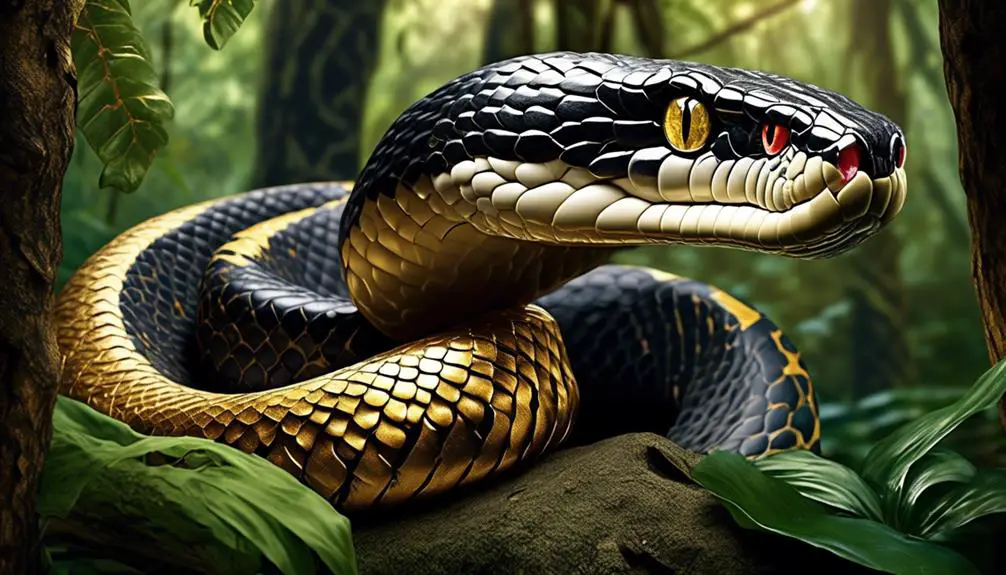
The King Cobra, also known as Ophiophagus Hannah, is an iconic and easily recognizable snake commonly found in Vietnam and other parts of South and Southeast Asia.
It can grow up to five meters in length, making it one of the largest venomous snakes in the world.
The King Cobra possesses powerful cytotoxins and neurotoxins in its venom, which can lead to organ shutdown and a range of symptoms including drowsiness, blurred vision, paralysis, and slowing heart beat.
Length and Appearance
With its iconic appearance and impressive size, the King Cobra, also known as Ophiophagus hannah, is a formidable and easily recognizable snake found in Vietnam and other parts of South and Southeast Asia.
The King Cobra is known for its length, capable of growing up to five meters long, making it the longest venomous snake in the world. Its body is slender and covered in smooth scales that range in color from olive green to dark brown.
The King Cobra’s most distinctive feature is its hood, which it can expand when threatened, displaying a pattern of alternating black and white or yellow bands. This striking appearance serves as a warning to potential predators and rivals, emphasizing its venomous nature and readiness to defend itself.
Potency of Venom
To truly understand the potency of the venom possessed by the King Cobra (Ophiophagus hannah), one must delve into the intricate composition of its lethal cocktail. The venom of the King Cobra contains a combination of cytotoxins and neurotoxins, making it one of the most deadly in the world.
These toxins have devastating effects on the human body, leading to organ shutdown and potentially fatal consequences if left untreated. The symptoms of a King Cobra bite include drowsiness, blurred vision, paralysis, and slowing heart rate. To give you a sense of the potency of its venom compared to other venomous snakes in Vietnam, here is a table showcasing the mortality rates associated with their bites:
| Snake Species | Mortality Rate |
|---|---|
| King Cobra | 75-80% |
| White-lipped Viper | 20-30% |
| Feas Viper | 40-50% |
| Malayan Krait | 60-70% |
As you can see, the King Cobra’s venom is incredibly potent, with a mortality rate that surpasses that of other venomous snakes in Vietnam. Its venom is a formidable weapon, capable of causing severe harm and even death.
Common Habitat and Distribution
Having established the potency of the King Cobra’s venom, it’s crucial to explore its common habitat and distribution in order to understand its ecological niche and geographic range in Vietnam.
The King Cobra, scientifically known as Ophiophagus hannah, is a widely distributed species found in various parts of South and Southeast Asia, including Vietnam. This iconic snake is known to inhabit a range of habitats, including forests, grasslands, and even agricultural areas. It’s often found near water sources, such as rivers and streams. The King Cobra’s adaptability allows it to thrive in both lowland and mountainous regions, making it a versatile species in terms of habitat selection.
Its distribution in Vietnam is widespread, covering many provinces throughout the country. Understanding the common habitat and distribution of the King Cobra is essential for conservation efforts and ensuring human safety in areas where this venomous snake is present.
Feas Viper (Azemiops feae)
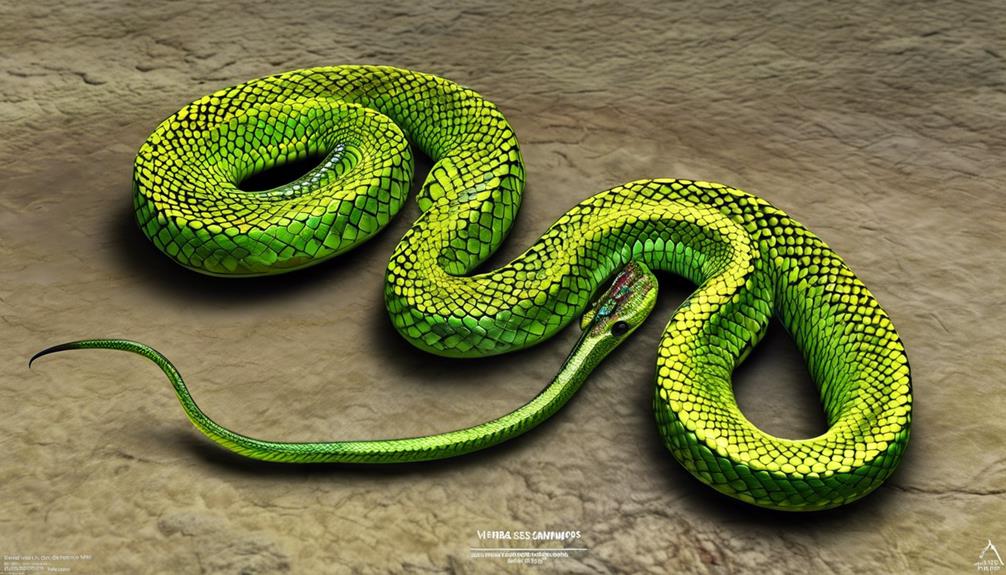
The Feas Viper, also known as Azemiops feae, is a venomous snake found in Vietnam, Tibet, and China. This small snake never exceeds a meter in length and can be found in bamboo forests and forested floors.
While the Feas Viper is unlikely to attack unless threatened, its venom can cause paralysis, bleeding, and extreme pain. The venom of this snake contains a mixture of components that can have both hemotoxic and neurotoxic effects on its prey.
The hemotoxic components lead to local tissue damage, bleeding, and swelling, while the neurotoxic components can cause paralysis and respiratory failure. It’s important to note that the Feas Viper, like other venomous snakes, plays an important role in the ecosystem by controlling populations of small mammals and other prey species.
However, caution should be exercised when encountering this snake, as its venom can pose a significant threat to humans if bitten.
Malayan Krait (Bungarus candidus)
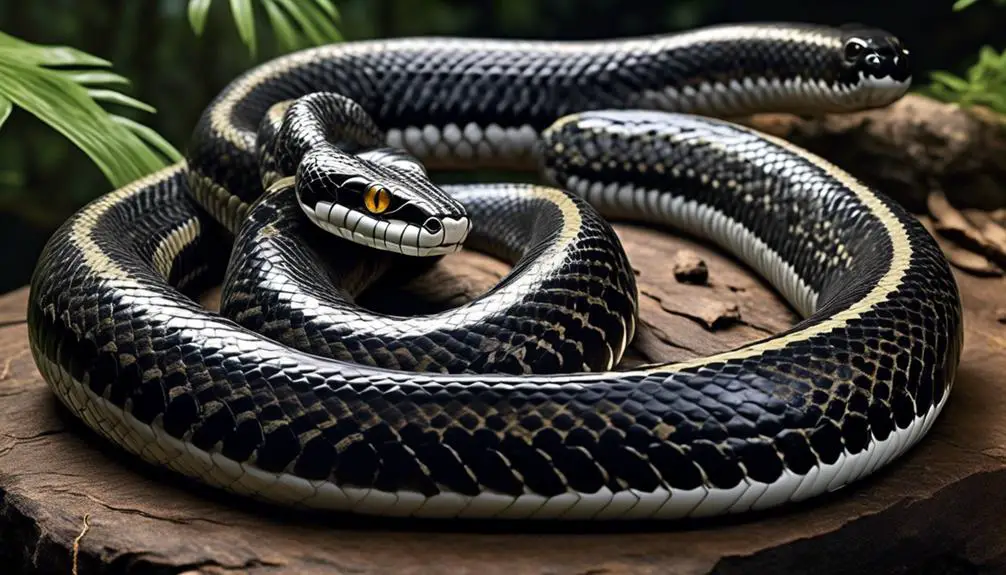
The Malayan Krait, scientifically known as Bungarus candidus, is a highly venomous snake found in Southeast Asia, including Vietnam. This snake is known for its eye-catching coloring, which can be confused with non-venomous snakes. However, its venom is one of the most toxic and potent among all snakes. The mortality rate among humans who are bitten by the Malayan Krait is alarmingly high, ranging from 60% to 70% if left untreated. The venom of this snake is capable of shutting down organs and the nervous system, leading to coma and cardiac arrest.
To give you a better understanding of the Malayan Krait, here is a table comparing it to other venomous snakes in Vietnam:
| Snake Species | Size | Venom | Mortality Rate |
|---|---|---|---|
| Malayan Krait | Small | Highly toxic | 60-70% if untreated |
| White-lipped viper | Less than a meter | Painful | Moderate |
| King cobra | Up to five meters | Neurotoxic | High |
| Feas viper | Small | Paralyzing | Moderate |
| Red-headed krait | Unknown | Potent and toxic | Unknown |
| Malayan pit viper | Unknown | Tissue damage | Moderate |
| Thai spitting cobra | Unknown | Painful | Moderate |
| Waglers pit viper | Unknown | Pain and swelling | Moderate |
| Many-banded krait | Unknown | Neurotoxic | High |
As you can see, the Malayan Krait stands out due to its highly toxic venom and the alarming mortality rate associated with its bites. It is essential to exercise caution and avoid any interactions with this snake to ensure your safety.
Red-Headed Krait (Bungarus flaviceps)
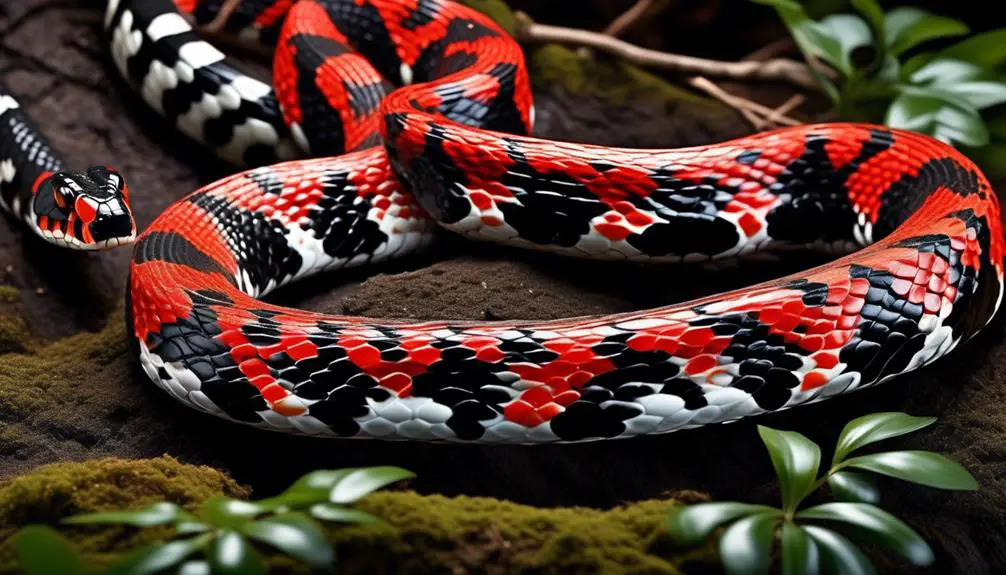
With its dramatically colored black body and bright red head, the Red-Headed Krait (Bungarus flaviceps) is one of the most venomous snakes found in Vietnam. This snake is characterized by its striking appearance, which can be mistaken for that of non-venomous snakes in the region. The Red-Headed Krait is a rarity in Vietnam, making encounters with it unlikely. As a result, the potency and toxicity of its venom and its effects on humans aren’t well-known.
Scientific research on the Red-Headed Krait is limited, and therefore, specific information about its venom is scarce. However, it’s important to exercise caution and treat encounters with this snake as potentially dangerous. The venom of the Red-Headed Krait is believed to contain neurotoxins that can affect the nervous system. Bites from this snake may result in symptoms such as muscle paralysis and respiratory failure.
Given the limited knowledge about the Red-Headed Krait, it’s crucial to prioritize safety and avoid any unnecessary interactions with this venomous snake. If you encounter a snake with a black body and bright red head in Vietnam, it’s advisable to keep a safe distance and seek immediate medical attention if bitten.
Malayan Pit Viper (Calloselasma)
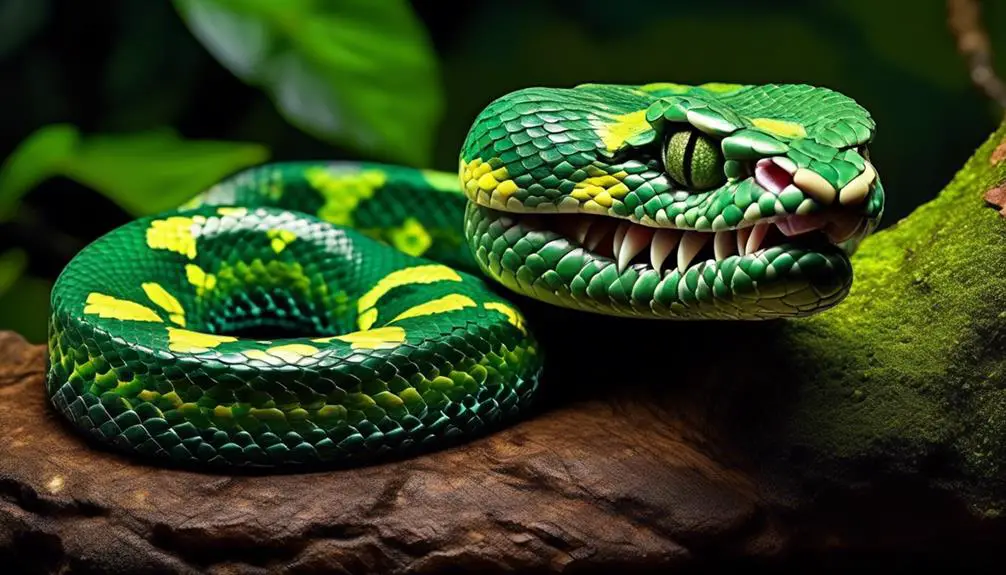
The Malayan Pit Viper, also known as Calloselasma, is a venomous snake found in Vietnam and other parts of Southeast Asia. Its venom is known for its potency and ability to cause tissue damage and blood clotting. Typically found in lowland rainforests and agricultural areas, this snake isn’t usually aggressive but can bite if threatened, resulting in severe pain, swelling, and blistering.
Venom and Toxicity
Venom and toxicity of the Malayan Pit Viper, also known as Calloselasma, are subjects of scientific scrutiny due to the potent venom and its effects on the human body. This snake, found in Vietnam and other parts of Southeast Asia, possesses venom that can cause tissue damage and blood clotting. Typically found in lowland rainforests and agricultural areas, the Malayan Pit Viper is not usually aggressive but can bite if threatened. Bite symptoms include severe pain, swelling, and blistering. To provide a clearer understanding of the venom and toxicity of the Malayan Pit Viper, the following table highlights its characteristics:
| Venom | Effects on Human Body |
|---|---|
| Causes tissue damage | Severe pain |
| Induces blood clotting | Swelling |
| Blistering |
Through scientific investigation, researchers aim to unravel the intricacies of this snake’s venom and its impact on the human body.
Habitat and Behavior
Malayan Pit Vipers, also known as Calloselasma, primarily inhabit lowland rainforests and agricultural areas in Vietnam and other parts of Southeast Asia. These snakes are typically found in areas with dense vegetation, such as forests and plantations, where they can camouflage themselves among the leaves and undergrowth.
They’ve a preference for moist environments and are often encountered near water sources, such as rivers and streams. Malayan Pit Vipers are known for their relatively sedentary behavior, spending much of their time hidden and motionless, waiting for prey to pass by. They aren’t overly aggressive and will usually only bite if they feel threatened or cornered.
When disturbed, they may assume a defensive posture, coiling their bodies and displaying their fangs as a warning. If bitten, humans can experience severe pain, swelling, and blistering, as the venom of the Malayan Pit Viper can cause tissue damage and blood clotting.
Bite Symptoms and Treatment
Moving on to the topic of bite symptoms and treatment for the Malayan Pit Viper (Calloselasma), it’s crucial to understand the potential effects of its venom and the necessary measures for medical intervention.
When bitten by a Malayan Pit Viper, you can expect to experience severe pain, swelling, and blistering at the site of the bite. The venom of this snake is known to cause tissue damage and blood clotting, which can lead to further complications if left untreated.
Immediate medical attention is essential to prevent the spread of the venom and to manage the symptoms effectively. Treatment usually involves the administration of antivenom to counteract the effects of the venom. Additionally, supportive care, such as wound care and pain management, may be necessary to aid in the healing process.

